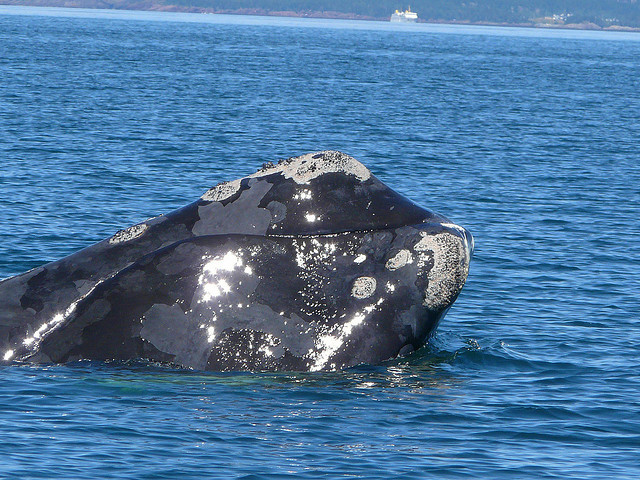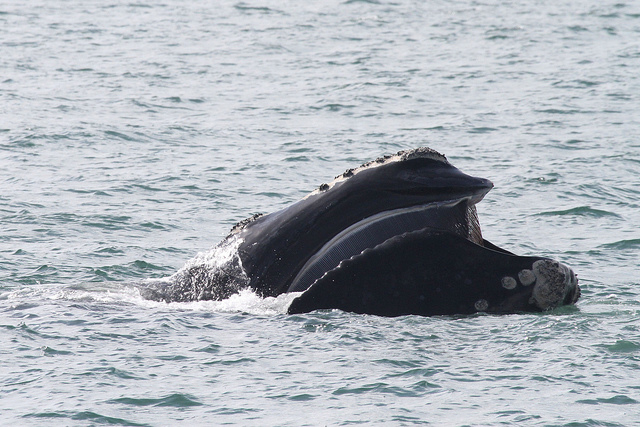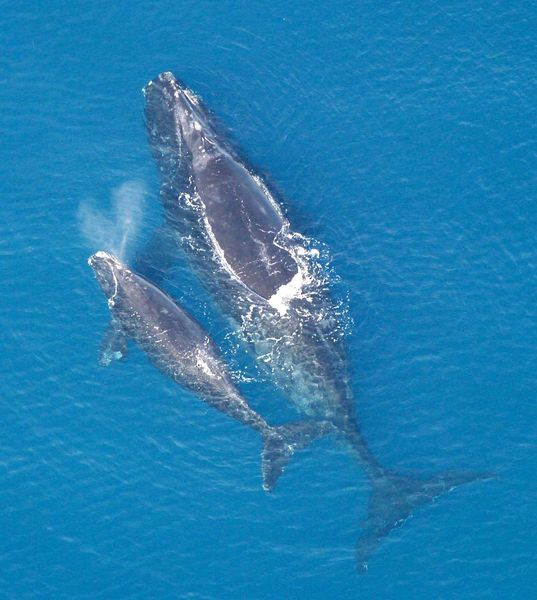Right whale; photo by Head Harbour Lightstation on Flickr (noncommercial use permitted with attribution / no derivative works).
Northern Right Whale
South Carolina designated the northern right whale as the official state migratory marine mammal in 2009. The right whale can be found off the South Carolina coast during the breeding and calving season.
The right whale's existence has been threatened since it was named right whale by whalers about 800 years ago (the "right" whale to hunt because they swim slowly, close to the surface, close to shore, and float when killed because of the abundant blubber). The whale's oil was used in lamps and perfume; their baleen for buggy whips, umbrella ribs, corset stays, hair brushes, and many other articles. The baleen alone on a right whale could make a voyage profitable for the whalers.
By the late 1800's there were so few right whales left that hunting them was not profitable, and today it is critically endangered with only about 350 left. Some scientists believe they will not escape extinction. Although hunting the northern right whale has been illegal for almost 100 years, their numbers are not increasing. Because they swim and rest very close to the surface, many are killed by colliding with ships. Fishing nets are also a serious hazard. Some scientists also believe that the pollution in the ocean is affecting the growth of the krill and plankton on which they feed. Add to all this the fact that a female Right whales give birth every three to five years to a single calf.
Whales are divided into two groups - the toothed whales(odontoceti) and the baleen whales(mysticeti). Toothed whales eat fish,squid, octupus & other sea creatures and have one blowhole. The largest toothed whale is the Sperm whale which grows to about 50-60 feet long. Baleen whales are larger than toothed whales and have two blowholes. The largest baleen whale is the Blue whale which is the largest animal that has ever lived on earth - with length up to 110 feet and weighing up to 174 Tons.
A Northern right whale (Eubalaena glacialis glacialis) grows to about 50 feet long and weighs about 120,000 pounds. Southern right whales (Eubalena glacialis australis) are a little larger, growing up to 54 feet long. In both species the male is slightly smaller than the female.
The Northern right whale (like all baleen whales) is a seasonal feeder that filter feeds crustaceans and plankton from the water. Baleen whales have baleen plates instead of teeth. Baleen is made of keratin (the same substance as fingernails) - in the case of the Northern right whale it hangs in a comb-like series of bristles up to 9.5 feet long from the upper jaw. The Northern Right whale swims slowly with it's mouth open and the baleen filters the krill (small shrimp-like crustaceans), plankton (plankton is made up of many tiny plants and animals), and capepods (also tiny crustaceans) from the water. Alaska also has a filter feeding whale as the state marine mammal - Bowhead whale.
Help Save the Northern Right Whale
The North Atlantic right whale is one of the most endangered species on the planet. There are only about 360 of these whales left, and they are facing a number of threats, including:
- Entanglement in fishing gear: Right whales are often entangled in fishing gear, which can injure or kill them.
- Collisions with ships: Right whales are also vulnerable to collisions with ships, which can cause serious injuries or death.
- Climate change: Climate change is causing the North Atlantic right whale's food sources to move, which makes it harder for them to find food.
We can all help to save the North Atlantic right whale by taking steps to reduce these threats. Here are some things you can do:
- Support organizations that are working to protect right whales: There are a number of organizations that are working to protect right whales. You can support these organizations by donating money or volunteering your time.
- Be aware of the threats to right whales: If you are out on the water, be aware of the signs of right whales, such as their distinctive V-shaped blow. If you see a right whale, be sure to stay at least 100 yards away.
- Reduce your carbon footprint: Climate change is a major threat to right whales, so reducing your carbon footprint can help to protect them.
Together, we can make a difference for the North Atlantic right whale. Let's work together to save this amazing creature from extinction.



